

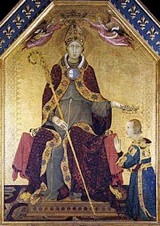
Altarpiece (ca. 1317) attributed to Simone Martini
in which St Louis crowns his brother, King Robert of Naples
Capodimonte Museum, Naples
An entry in the Roman Martyrology under 19th August reads: “ In Provence, at the village of Brignoles, the death of St Louis, bishop of Toulouse, of the Order of Friars Minor, renowned for holiness of life and miracles. His body was taken to Marseilles, and buried with due honours in the Church of the Friars Minor, but afterwards it was taken to Valencia in Spain, and enshrined in the cathedral”.
Provence, Sicily, Hungary and Jerusalem
St Louis (1274-97) was born in the county of Provence that was then ruled by his grandfather, Charles d’ Anjou, King of the Two Sicilies (i.e. of Naples and Sicily), Provence and Jerusalem. He stood behind his father, Charles of Salerno (the future King Charles II of Naples) and his older brother, Charles Martel, in the line of succession to these titles. The brothers also featured in the line of succession to the throne of Hungary, by virtue of their mother Maria of Hungary, the daughter of King Stephen V.
In 1282, the Aragonese invaded the island of Sicily, leaving Charles d’Anjou with Naples. In the following hostilities, they captured Charles of Salerno and held him hostage at the Aragonese court, and he was still there in 1285, when Charles d’ Anjou died. He was released from captivity in 1288, and Pope Nicholas IV crowned him in 1289. However, he was forced to leave his sons Louis, Robert d’ Anjou and Raymond Berengar as hostages. St Louis spent the next seven years (from age fourteen to twenty-one) in a remote fortress in Catalonia.
Four events that occurred during this period of captivity transformed the royal status of St Louis:
-
✴Charles Robert, the son born to Charles Martel in 1288, potentially moved ahead of him in the lines of succession in Naples and Hungary (as the oldest son of the oldest son);
-
✴King Ladislas IV, the brother of Mary of Hungary was assassinated in 1290, giving Charles Martel a strong claim to the Hungarian throne, albeit that a distant relative of the Hungarian royal family was crowned as King Andrew III;
-
✴when Charles Martel died in 1295, Charles II named St Louis as heir to the throne of Naples, while recognising the claim of the seven-year-old Charles Robert, by right of his grandmother, to the throne of Hungary.
St Louis and the Franciscans
St Louis spent his time of imprisonment in the care of two formidable Franciscans:
-
✴Francis le Brun, the future bishop of Gaeta, who was his tutor and confessor; and
-
✴Peter Scarrerii, future Bishop of Rapolla.
During this period, he also wrote to Peter John Olivi and met Raymond Gaufridi, both of whom were prominent Franciscan Spirituals. These contacts were to lead to his own Franciscan vocation. He also secretly took minor orders while in captivity, although this did not bind him to perpetual celibacy.
St Louis and his younger brothers were finally released in 1295, shortly after the death of Charles Martel. On the journey back to Provence, and in the presence of his father, St Louis took minor orders, this time without any secrecy, and received the tonsure. The party continued to Rome, where Pope Boniface VIII ordained St Louis as a sub-deacon in St Peter’s on Christmas day, 1295. St Louis renounced his right to the throne of Naples in favour of his brother, Robert in a ceremony at Naples early in 1296 and Boniface XIII confirmed these arrangements a year later. During this period, St Louis was ordained in Naples as a deacon and then as a priest. However, he was not yet able to realise his strongest desire: entry into the Franciscan Order.
When the Bishop of Toulouse died in Rome at the end of 1296, Boniface VIII proposed that St Louis should be appointed in his place. In order to placate his father, St Louis reluctantly agreed. He travelled to Rome with his father for his ordination, but he secretly informed Boniface VIII that he would proceed only if he were allowed to become a Franciscan. He received the Francsican habit from the Minister General, Brother John of Morrovalle, on Christmas Eve, 1296 (as did Count Guido I of Montefeltro), and was ordained as Bishop of Toulouse a few days later.
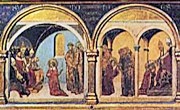
In these two panels from the predella of the altarpiece that is illustrated above:
-
✴St Louis agrees to his ordination by Boniface VIII as Bishop of Toulouse in return for papal approval of his entry into the Franciscan Order; and
-
✴John of Morrovalle receives him into the Order, after which Boniface VIII duly ordains him as Bishop of Toulouse.
The fact that St Louis had become a Franciscan became public when he celebrated Mass at the Franciscan church of Santa Maria Aracoeli, Rome in February 1297, in the presence of Cardinal Matthew of Acquasparta and other prominent Franciscans. The party then moved to dinner in the adjoining convent: St Louis wished to serve at table, but he was over-ruled by Guido I of Montefeltro, who was living at Santa Maria Aracoeli at that time.
St Louis finally arrived in his diocese in May, 1297. He faced a daunting task, but he was sensible enough to obtain the aid of Jacques Duèze (the future Pope John XXII), who was then teaching canon law at the University of Toulouse. His role as a bishop did not stop him leading a life of poverty worthy of St Francis: although he is often depicted wearing full regalia he in fact generally wore his Franciscan habit. He was inevitably unhappy with both the distractions and the trappings of office, and was trying to resign when he died at a tragically early age in August 1297 at Brignoles. Raymond Gaufridi and Jacques Duèze were with him when he died. He was buried, in accordance with his own wishes, in a simple tomb in front of the high altar of the Franciscan church of Marseilles.
Cult of St Louis of Toulouse
Charles II began to orchestrate the cause for the canonisation of St Louis from ca. 1300. He was frustrated by the deaths of Boniface VIII and Pope Benedict IX in quick succession and the subsequent papal inter-regnum. However, he returned to the matter with the election of Pope Clement V in 1306. He established the papal court in the Angevin county of Provence, and the official investigation of the life and miracles of St Louis opened in 1307. The depositions of the witnesses, who included Raymond Gaufridi and Jacques Duèze, survive. Charles II died in 1309 but his widow, Maria of Hungary and his son, now King Robert of Naples, continued the campaign.
The results of the canonisation proceedings were still being digested when Clement V died in 1314. There was then a two-year inter-regnum. However, the election of Jacques Duèze as John XXII in 1316 was decisive: St Louis was canonised in the following year. It was probably at this point that King Robert of Naples (or perhaps his mother, Queen Maria of Hungary) commissioned the altarpiece illustrated above, which celebrates the canonised St Louis and the legitimacy of his replacement by King Robert (rather than by Charles Robert) in the Neapolitan succession.
King Robert was not able to attend the service of canonisation of St Louis. However, he probably commissioned the altarpiece illustrated above in order to commemorate the event. (The subtext was probably a claim of heavenly approbation of the abrogation of the rights of Charles Robert in respect of the throne of Naples). He then left Naples in 1318 for what proved to be a long stay at the papal court in Avignon. In 1319, he presided over the translation of most of the remains of St Louis to a new tomb in the choir of the church in Marseilles, and arranged for other relics to be sent to Naples. Sancia, the wife of King Robert commissioned reliquaries at Naples for the head and arm of St Louis had made for the arm of St Louis: the latter is now in the Louvre, Paris.
In 1423, troops of King Alfonso V of Aragon threatened Marseilles during the fight between Alfonso Louis III D’ Anjou, Count of Provence over the succession to the throne of Naples. The remains of St Louis were removed from the church and hidden, but Aragonese soldiers found them. The cult of St Louis was popular in Aragon: his sister Blanche had married King James II of Aragon as part of the deal by which St Louis and his brothers had been released from captivity there. Alfonso V therefore took the relics to Valencia. They still survive in the cathedral there.
Assisi
The lower church of San Francesco, Assisi was one of the places that the Angevins sponsored as a cult site for St Louis after his canonisation (as described in the page on San Francesco in the 14th Century).
The Cappella di San Ludovico in the lower church of San Francesco was almost certainly completed in ca. 1312, some five years before the canonisation of St Louis (although the process was well underway), and was probably originally dedicated (at least formally) to his great uncle, St Louis IX of France.
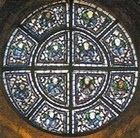
-
✴he is depicted without a halo, and
-
✴is identified simply as “F. Lodovic[us]” (brother Louis).

-
✴in one, he is dressed as Bishop of Toulouse, receiving the blessing of Christ ; and
-
✴in the other, he is dressed as a layman, kneeling before St Francis.
This suggests that, while the chapel itself pre-dates his canonisation, the glass was installed shortly thereafter.
St Louis is depicted in two frescoes in the lower church that were probably also commissioned soon after his canonisation, both of which are attributed to Simone Martini:
-
✴He is also depicted under the entrance arch of the Cappella di San Martino against a backdrop with the Angevin arms, next to St Louis IX of France.
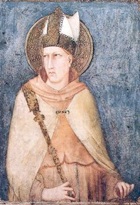
-
✴He is among the saints depicted near the Altare di Sant’ Elisabetta in the right transept, wearing his Franciscan habit under his episcopal robes and and resting his renounced crown of Naples on the fictive frame.
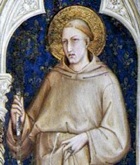
Perugia
The city of Perugia named St Louis as its fourth patron saint in 1325. This was done for political reasons since King Robert of Naples was the leader of the Guelf alliance to which Perugia belonged. [Frescoes in Palazzo dei Priori]




